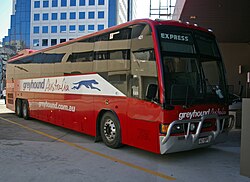|
Greyhound Australia
Greyhound Australia is an Australian coach operator that operates services in all mainland states and territories. It is owned by Entrada Travel Group. The company was established in 1928 and is not affiliated with similarly named companies in other countries. History   Greyhound Coaches was formed in Toowoomba in 1928 by Russell Penfold with a service between Toowoomba and Brisbane. In 1956 and again in 1962 Greyhound attempted to enter the interstate passenger express field but without success. In 1968, after entering the market a third time, the company succeeded in establishing services between Brisbane, Sydney, Melbourne and Adelaide with Perth and Darwin added in the 1970s creating a national coach company.[1] In 1975, the South Australian operations were franchised to Adelaide operators, Murray Valley Coaches, and Stateliner.[2] In November 1989, the Penfold family sold Greyhound Coaches to Stateliner with the exception of the Brisbane - Gold Coast and Brisbane - Toowoomba services that were sold separately.[3] In 1992 Greyhound, Pioneer and Bus Australia merged with the combined operation rebranded Greyhound Pioneer Australia.[4][5] In February 1999, Queensland Coach Company was formed by Greyhound Pioneer Australia to body 94 Scania coaches over five years to renew the fleet.[6] Originally an alliance was formed with bodybuilder Alan B Denning with it proposed the Galaxy body design be used. However, following the collapse of the Clifford Corporation, the rights to the Austral Pacific Majestic body were purchased.[7] In July 2000, Queensland Coach Company ceased trading and was put into administration.[8] In March 2000, Greyhound Pioneer Australia entered discussions with McCafferty's Coaches about a potential merge.[9][10] Subsequently Premier Motor Service made an unsuccessful takeover bid for the business.[8][11] In September 2000, a takeover bid from McCafferty's was accepted.[5][12][13] In October 2004, McCafferty's sold the combined business to ANZ Bank and George Chapman with both operations rebranded as Greyhound Australia.[5] In 2006 ANZ sold its shares to KordaMentha.[14] In 2005, the Sunshine Coast to Byron Bay services of Suncoast Pacific were purchased.[15] In October 2011, the Oz Experience backpacker business was purchased.[14] In 2019, Greyhound Australia signed a three-month contract with BMD Group, a construction company that is building the railway from the planned Carmichael coal mine to Abbot Point. After the contract became public in early 2020, the Citizens of the Great Barrier Reef Foundation withdrew from its partnership with Greyhound and School Strike 4 Climate announced that it was planning to boycott the company. Greyhound subsequently announced that it would be withdrawing from the contract "following considered deliberation, and in the best interests of our staff, customers, and partners".[16] In February 2021, Greyhound Australia agreed terms to sell its Greyhound Resources business that provides mine transport for workers in the Bowen Basin, Hunter Valley, South Australia and Northern Territory to the Kinetic Group with 170 vehicles. The deal is expected to close in April 2021.[17] From 11 December 2021 onwards, Greyhound Australia will once more be servicing the intercity routes it lost on 31 December 2014 to Bus Queensland Toowoomba.[citation needed]
RoutesGreyhound Australia's routes, as at February 2020, are:[18]
Former routes
Other servicesGreyhound Australia provide coaches for transportation of mine workers, coaches used on these duties carry large fleet numbers, fluorescent yellow stripes and a roof mounted flashing orange light. Between July 2010 and June 2014, Greyhound Australia operated services between Lithgow and Gulgong, Coonabarabran and Baradine under contract to CountryLink.[24][25][26] Some intrastate services in Queensland are subsidised by the Queensland Government.[27] FleetIn the 1970s, Greyhound imported a fleet of Eagle 05 and 10 coaches.[28] In the 1980s it purchased Austral Tourmasters and Volgren bodied Volvo B10Ms. In 1995, it standardized on Scania coaches. When merging with McCafferty's in 2004 it inherited Austral Denning Highlanders, Denning Denairs, Denning Landseers (including their high deck variants) and Motorcoach Australia Marathons and Classics.[29] More recently it has purchased Iveco, Mercedes-Benz and Volvos. As at January 2021, the fleet consisted of 228 coaches.[30] In the 1970s, Greyhound adopted an orange and white livery. In 1993 a grey, white and blue livery was introduced following the formation of Greyhound Pioneer Australia. McCafferty's gold livery was applied when it took over the business in 2000 before the current red livery was introduced in 2004.[citation needed] Other Greyhound operationsDespite its name, Greyhound Australia has never had any affiliation with Greyhound Lines, Greyhound Canada, Greyhound Mexico or Greyhound UK. References
External links
|
||||||||||||||||||||
